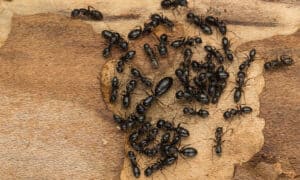Ant enthusiasts, get ready! This summer, the state of Indiana is gearing up to witness an array of ant species emerge from their underground nests. From industrious worker ants to ferocious soldier ants, each species boasts unique traits and behaviors that are nothing short of remarkable.
Whether you’re a seasoned ant watcher or a curious beginner, this season promises to be a thrilling adventure. So, get ready to witness the bustling activity of these tiny but mighty creatures as they make their presence known in Indiana this summer.
5 Types of Ants to Emerge in Indiana This Summer
Little Black Ant (Monomorium minimum)
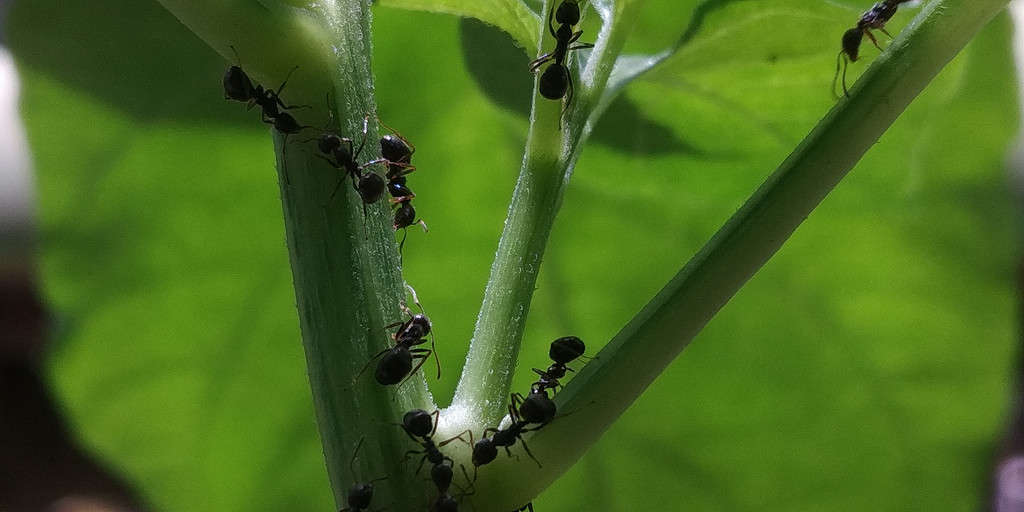
One of the most prevalent species of ants that will emerge in Indiana this summer is the little black ant, renowned for its single file lines.
©iStock.com/Rahmat M Pandi
In Indiana, little black ants are often spotted invading picnics. They are renowned for their unique march in single file lines, forming “roadways.”
These ants are one of the more prevalent species in the state, and they are typically dark brown, black, or jet black in color. Their antennae have twelve segments and end in a club with three segments. Unlike most ants, little black ants have a shiny appearance, and they measure between 1/16″ to 1/8″ in length, with the queens being a bit larger at 1/8″.
Wooded areas are a common place to find little black ants. When outside, they establish nests under rocks, rotting logs, or piles of bricks or lumber. They may also form nests indoors in places such as wall voids, woodwork, masonry, behind facades, and decaying wood.
Little black ants feed on a variety of items, including oil, grease, fruits, meats, vegetables, and sweet materials. Workers may also consume other insects, plant secretions, and honeydew.
Little black ant bites are less noticeable than those from big black carpenter ants. Although they may sting, they rarely pose a danger.
Between June and August, little black ants often swarm while foraging in trails and are commonly found on sidewalks. They usually hibernate during the winter, but warm spells may trick them into emerging to seek food. If ants are present inside homes during winter, it is likely they have established a colony indoors.
Black Carpenter Ant (Camponotus pennsylvanicus)
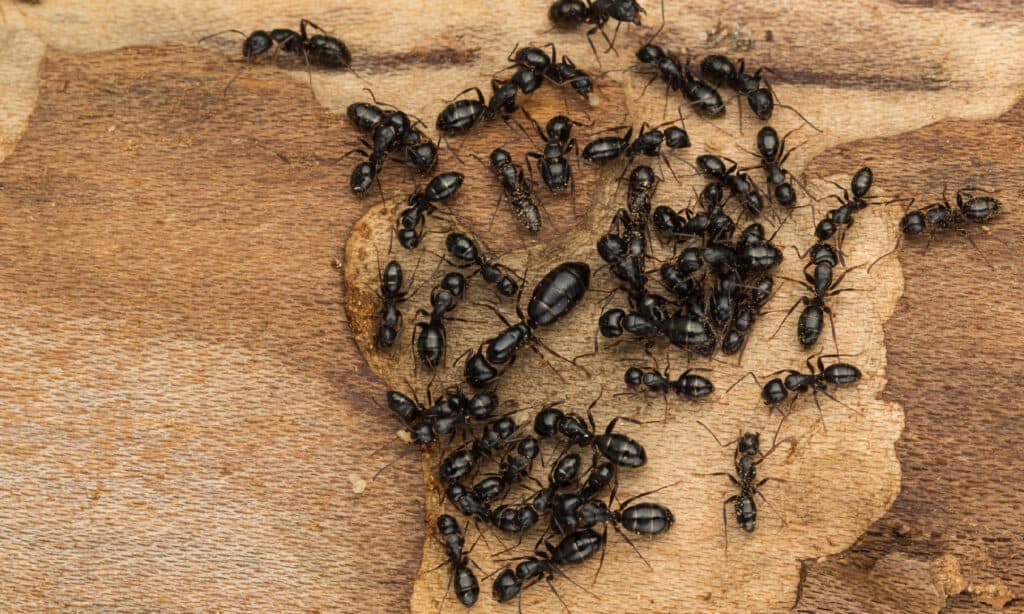
Black carpenter ants are the largest species in the United States and have become a pest problem in Indiana.
©iStock.com/DianaLynne
Southern Indiana often faces a pest problem with black carpenter ants, which are the largest species of pest ants in the United States. While black carpenter ants may not be directly dangerous to humans, they can still inflict substantial harm on the buildings they invade.
Black carpenter ants can grow up to half an inch in length and are identified by yellowish hairs on the abdomen and their black color. When the colony reaches maturity, the queen produces winged males and females that exit the nest to mate and create new colonies.
In their natural habitat, carpenter ants nest in decaying wood and dead logs in forests, where they excavate tunnels and nest cavities by chewing wood without consuming it.
Surprisingly, the black carpenter ant’s preferred food is a sugary dew-like juice produced by aphids. To obtain the dew, black carpenter ants protect and feed the aphids and occasionally consume other insects as well.
Black carpenter ants are active from March to April, and their activity usually lasts until early fall, which falls between September and October. In the spring, a mature carpenter ant colony typically releases reproductive individuals.
Pavement Ant (Tetramorium immigrans)

Pavement ants can be found in urban areas of Indiana, often creating nests under patios, building foundations, and sidewalks.
©Ernie Cooper/Shutterstock.com
Pavement ants are commonly found in Indiana, where they create nests by piling soil on the pavement.
These ants are typically brownish-black and small, measuring around 0.1 to 0.2 inches in size. Like other ant species, pavement ants have a narrow waist and two nodes between their abdomen and thorax.
In natural environments, pavement ants can be found living under rocks and debris in meadows. However, in urban settings, they often create nests under patios, building foundations, and sidewalks. Pavement ant workers may often enter homes, and if they find sources of food, they may recruit other colony members indoors as well, making them a particularly bothersome ant species. While larger colonies may have additional queens, there is usually only one queen per colony.
Pavement ants have an omnivorous diet that comprises honeydew, sweets, oil, seeds, and insects. These social insects form large colonies that can have over 10,000 workers.
While pavement ants usually forage at night, they may also forage during the day in the early spring and summer. These ants can frequently be seen in Indiana from April through September.
Thief Ant (Solenopsis molesta)

Thief ants are very small in size and can vary in color from yellow to bronze to dark brown.
©Carlos Calvo Torregrosa/Shutterstock.com
Due to their small size, thief ants, an ant species native to the United States, frequently remain unnoticed.
Their size typically ranges from 1/32 inch to 1/8 inch, with the majority measuring about 1/16 inch. Their appearance can vary from yellow to bronze to dark brown, and they have a smooth, shiny texture. The petiole of the thief ant is made up of two segments, and they possess 10-segmented antennae that end in a two-segmented club.
Thief ants can survive in a variety of habitats, which makes their distribution quite extensive. They can live inside human homes, beneath floorboards, or within cracks. They often build their nests near other ant colonies that they can steal from.
These ants consume anything in their path, including deceased animals, fungal spores, and even the larvae of other ants. They can travel long distances to find food.
Thief ants are common household pests, and their small size allows them to enter sealed food packages easily. In addition to raiding human dwellings, they can also invade other ant colonies to pilfer food.
Thief ant mating swarms occur from June to September, and during summer months, the reproductive ants may be seen indoors.
Odorous House Ant (Tapinoma sessile)
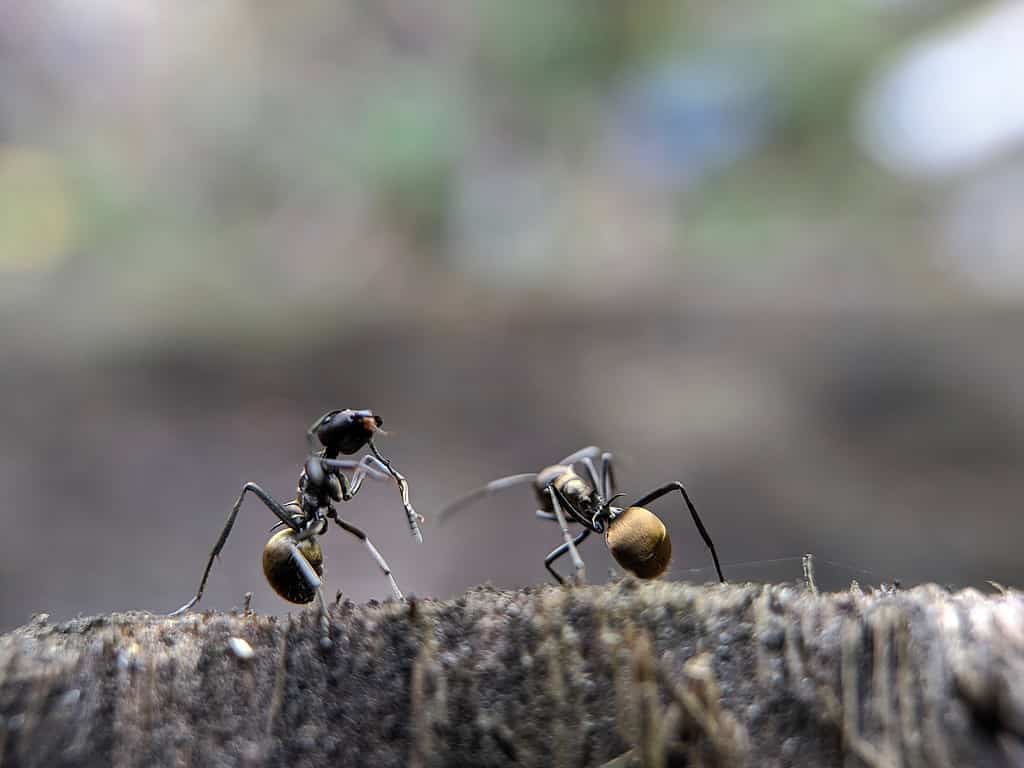
Odorous house ants are known for having a sweet tooth as they are drawn to sugary substances.
©Dhe Tong/Shutterstock.com
In Indianapolis, one of the common types of ants that can be found is the odorous house ant. These ants are usually dark brown or black, and they measure about 1/8 inch in length. Identifying them might be challenging because their waist, or petiole, has a flat node that may be obscured by other parts of their bodies. Additionally, they have antennae composed of twelve segments that lack a well-defined club.
When living indoors, odorous house ants typically establish their nests near areas with high moisture levels. Examples of these areas include wall voids near hot water pipes, inside heaters, beneath leaky fixtures, and within the wood that has been damaged by termites. As for outdoor habitats, odorous ants tend to reside in exposed soil or under piles of firewood.
Odorous house ants have a sweet tooth, as they are particularly drawn to sugary substances such as honeydew. Nevertheless, they are not fussy eaters and will consume almost anything found indoors.
These ants usually move around in groups, following a trail while foraging for food both day and night. Although they are frequently seen between March and August or September, odorous house ants can live inside homes throughout the year. Rainy weather tends to increase the likelihood of odorous house ants entering buildings.
Other Insects Set to Emerge In Indiana
In Indiana, summer brings not only hot weather but also an influx of various other insects. Let’s take a closer look at some of the other insects that are expected to swarm across the state.
European Chafer (Amphimallon majale)
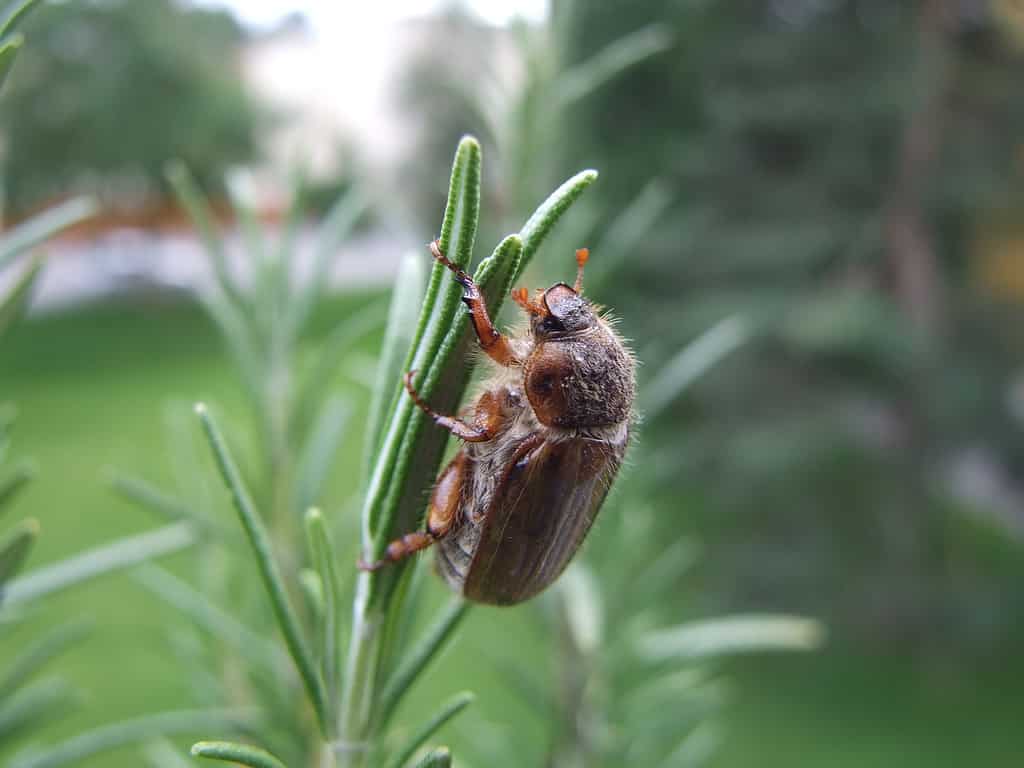
The European chafer beetle is typically active during Indiana’s summer months.
©Mario Krpan/Shutterstock.com
The European chafer beetle, once only seen in continental Europe, has now invaded temperate regions of North America, including Indiana. These beetles are similar to June beetles, measuring only about 0.6 inches long, and have a tan or brown color.
These beetles can cause severe damage to homeowners’ lawns by destroying the turf. Additionally, it poses a threat to the agricultural industry by feeding on crop roots, which could lead to significant costs.
These beetles thrive in temperate grasslands, residential lawns, and gardens. Their natural predators include birds, toads, skunks, raccoons, and moles, which may help control their populations.
The European chafer beetle is typically active from June to August, making this period crucial for monitoring and controlling their population.
Eastern Lubber Grasshopper (Romalea microptera)

The months of July and August mark the peak season for eastern lubber grasshoppers in Indiana.
©iStock.com/passion4nature
Indiana is home to a distinctive type of grasshopper known as the eastern lubber. It displays a vibrant color pattern that can vary, with most adults being predominantly yellow or tawny, accentuated by black markings on the antennae, pronotum, and abdominal segments. These grasshoppers can grow up to 3 inches in size and typically move by walking since they are unable to fly or leap effectively.
Lubbers can be found in swamps, open woodlands, weedy fields, and ditches. These insects feed on plants that contain substances that are safe for humans and lubbers but poisonous to many predators. Consequently, consuming a lubber can either leave larger animals unwell or even cause the death of smaller creatures such as birds.
The months of July and August mark the peak season for eastern lubber grasshoppers in Indiana, making them a common sight during this time of year.
Common Eastern Bumble Bee (Bombus impatiens)
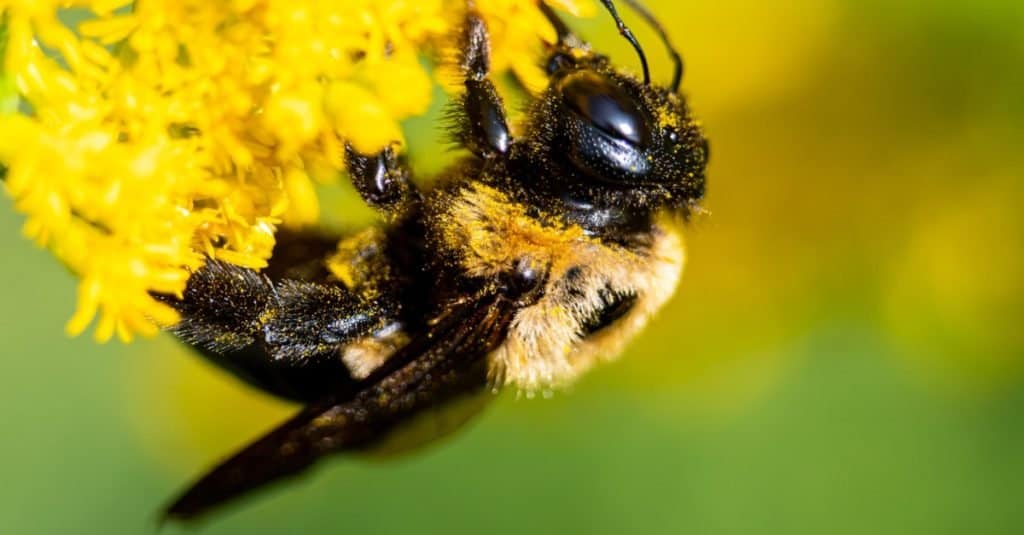
The common eastern bumble bee has a furry body helping it collect and trap pollen, which it transports from one flower to the next.
©Brier Mitchell/Shutterstock.com
The common eastern bumblebee is prevalent in North America and easily identifiable with its yellow thorax and black hair circle at the base of its wings. The queen bumblebees are larger than the workers, and the males have a distinctive yellow hair patch on their faces, resembling a mustache or beard.
Bumblebees are essential for pollinating various fruits and vegetables, such as tomatoes, blueberries, and cucumbers. This underscores the crucial role these insects play in the growth and propagation of many crops. The bees’ furry bodies collect and trap pollen, which they transport from one flower to the next.
The common eastern bumblebees, which have a social and colonial nature, can create exceptionally large colonies. During the day, the older common eastern bumblebees collect pollen, while the younger ones take care of the brood.
During winter, newly mated queen bumblebees hibernate until early spring, when they begin searching for a suitable nesting spot. These bees can be seen foraging for nectar around flowers until the month of October.
Common Wasp (Vespula vulgaris)
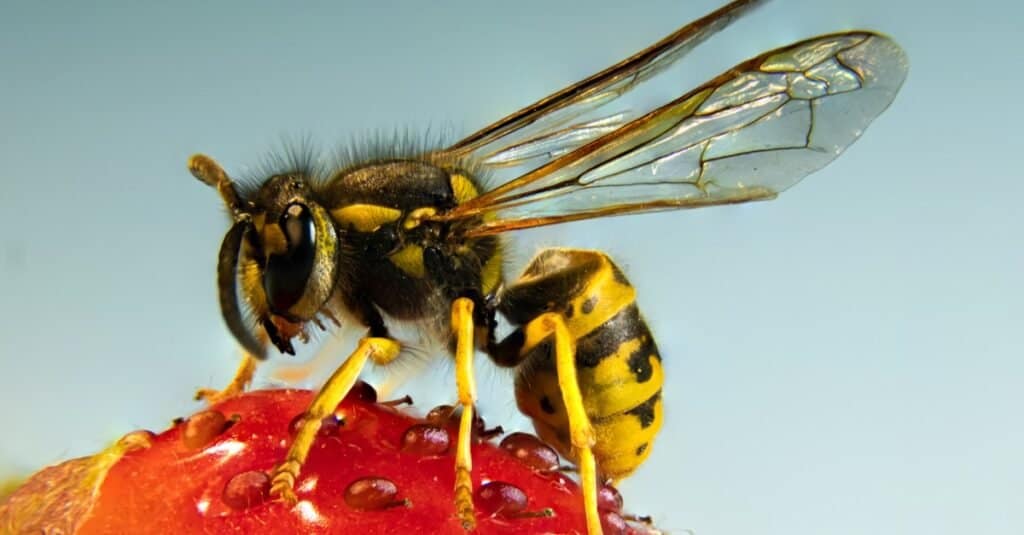
By June to July, the colony of common wasps is fully established, growing as large as 5,000 to 10,000 individuals.
©Thomas Hochreutener/Shutterstock.com
The common wasp is a frequently encountered species characterized by its black and yellow coloring, with parallel yellow pronotal bands and black dots and rings on its abdomen. This wasp is recognizable by a unique anchor-like symbol on its facial area and has a size that spans between 0.5 and 0.7 inches, while the larger females can reach 0.8 inches.
They inhabit diverse surroundings, such as garden spaces, open fields, and forested areas, and are known to dwell near human habitation.
Unlike honey bees, which perish after stinging, the common wasp can sting multiple times, making it more likely to sting if provoked by sudden movement or violent behavior.
The wasp’s annual cycle begins in the spring when queen wasps emerge from hibernation after winter. By June to July, the colony is fully established, and some can grow as large as 5,000 to 10,000 wasps. As fall approaches, however, the wasp population begins to decline, and by October, they disappear.
Emerald Ash Borer (Agrilus planipennis)

The emerald ash borer is an invasive wood-boring beetle responsible for the decline of ash trees.
©Herman Wong HM/Shutterstock.com
In 2002, North America witnessed the emergence of an invasive wood-boring beetle called the emerald ash borer, which originated in Asia. This beetle is responsible for the decline and ultimate death of ash trees, as its larvae feed on the tissue beneath the bark, hampering the tree’s ability to transport essential nutrients and moisture.
The emerald ash borer is identifiable by its metallic green hue and small size, measuring around half an inch in both length and width. While its back shimmers with an iridescent, metallic green color, the underside is a striking emerald green.
These beetles have a one-year life cycle, with their adult flight season ending by early August. Their larvae cause significant damage to ash trees by feeding on the tissue under the bark. The peak of their activity is typically between mid-June and early July, with emergence from beneath the bark occurring from late May to early June.
The photo featured at the top of this post is © Denis Vesely/Shutterstock.com
Thank you for reading! Have some feedback for us? Contact the AZ Animals editorial team.




